Common Applications Of Incoloy Capillary Tubes
What distinguishes Incoloy?
Incoloy is not a conventional metal; it is an advanced alloy. It is engineered to withstand severe conditions, including high temperatures, corrosive media and elevated pressures. It consists primarily of nickel, with minor amounts of iron and chromium; depending on the application, it may also incorporate molybdenum, copper or titanium. This material exhibits resistance to acids, high temperatures and saline environments.
Stainless steel appears shiny and stable. However, under rigorous conditions, it may develop rust or become porous, particularly in the presence of chlorides or acidic media. Incoloy maintains its dimensional integrity without degradation. Consequently, it is utilised in chemical processing plants, power stations and underwater applications.

A brief overview of the quality grades
Each grade of Incoloy meets specific performance requirements depending on the application:
- Incoloy 800/800H/800HT: These materials endure high temperatures and are resistant to oxidation and carburisation. They are suitable for use in ovens, steam generators and heat exchangers.
- Incoloy 825: This material demonstrates high resistance to acids such as sulphuric and phosphoric acid. It is employed in acid processing systems and in the reprocessing of nuclear materials.
- Incoloy 903 and A-286: These alloys exhibit ductility and stability at both low and elevated temperatures. They find application in the aerospace sector and high-pressure fuel systems.
Below is an overview table detailing the key Incoloy grades:
|
Incoloy Grade |
Key Properties |
Typical Applications |
|
- Exhibits resistance to oxidation and carburisation |
Heat exchangers, nuclear steam generators, oven components |
|
|
- Provides high resistance to sulphuric and phosphoric acid |
Chemical processing, acid production, nuclear fuel reprocessing |
|
|
903 & A-286 |
- Maintains excellent mechanical strength at both cryogenic and elevated temperatures |
Aerospace, high-pressure fuel and hydraulic systems |
Additional Incoloy products are available at Stanford Advanced Materials (SAM).
General applications of Incoloy capillary tubes
This discussion does not concern standard tubes but rather capillary tubes, which are narrow and machined to precise tolerances for use in systems where accuracy is critical.
In nuclear power stations, these tubes are employed in the monitoring and control of systems whose reliability is essential. A failure could necessitate a shutdown. Incoloy tolerates both radiation and elevated temperatures better than many other materials; it is selected for such environments.
In petrochemical plants and refineries, corrosive substances such as acids and sulphides are present. Incoloy tubes withstand these substances when used in sampling lines or injection systems.
High-temperature gas systems in applications such as gas turbines or reactors rely on these tubes. They convey superheated gases that would typically cause other materials to melt or deform. Incoloy remains dimensionally stable even at temperatures of up to 1 000 °C.
The aerospace sector also utilises Incoloy. In these applications, there is no margin for leaks or failure. Incoloy tubes are employed to transport fuel and hydraulic fluid under demanding conditions, thereby providing precise flow control.
Further reading: A Guide to Inconel Used in Oil and Gas Extraction
Selecting the correct tube for the intended application
The selection of the appropriate Incoloy capillary tube is made after careful consideration. The following factors must be taken into account:
- The environment: If acids, high temperatures or chlorides are present, choose the grade accordingly.
- Pressure and temperature: Not all alloys perform identically under load. Verify that the tube meets the required temperature and pressure limits.
- Dimensional accuracy: In capillary tubes, minor deviations can lead to significant issues, particularly in flow or pressure regulation.
- Conformity and standards: In industries such as nuclear, aerospace or pharmaceuticals, documentation confirming adherence to regulations is necessary.
- Cost versus durability: Although Incoloy may present a higher initial cost compared with stainless steel, its extended service life and reduced maintenance requirements can lower overall expenses.
The following table offers a concise overview of Incoloy capillary tubes and the associated ASTM standards:
|
Incoloy Capillary Tube |
Applicable ASTM Standards |
Description |
|
Nickel-Chromium-Iron Alloys, including Incoloy |
ASTM B163 |
Covers the requirements for high-temperature applications, including capillary tubes. |
|
Nickel-Chromium Alloys (non-welded tubes) |
Applies to non-welded tubes for aerospace, power generation and chemical processing. |
|
|
Nickel-Chromium Alloys (non-welded tubes) |
ASTM B407 |
Emphasises mechanical properties and corrosion resistance at elevated temperatures. |
Final considerations
If you operate in environments where material failure is hazardous, you require a material with proven performance. For this reason, Incoloy capillary tubes have established their role. They are commonly employed in critical applications within the energy, aerospace and chemical processing sectors.

 Bars
Bars
 Beads & Spheres
Beads & Spheres
 Bolts & Nuts
Bolts & Nuts
 Crucibles
Crucibles
 Discs
Discs
 Fibers & Fabrics
Fibers & Fabrics
 Films
Films
 Flake
Flake
 Foams
Foams
 Foil
Foil
 Granules
Granules
 Honeycombs
Honeycombs
 Ink
Ink
 Laminate
Laminate
 Lumps
Lumps
 Meshes
Meshes
 Metallised Film
Metallised Film
 Plate
Plate
 Powders
Powders
 Rod
Rod
 Sheets
Sheets
 Single Crystals
Single Crystals
 Sputtering Target
Sputtering Target
 Tubes
Tubes
 Washer
Washer
 Wires
Wires
 Converters & Calculators
Converters & Calculators
 Write for Us
Write for Us


 Chin Trento
Chin Trento



